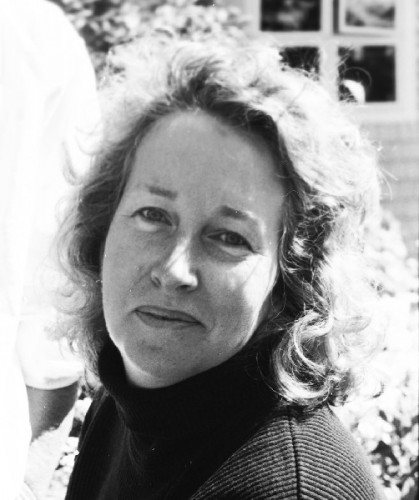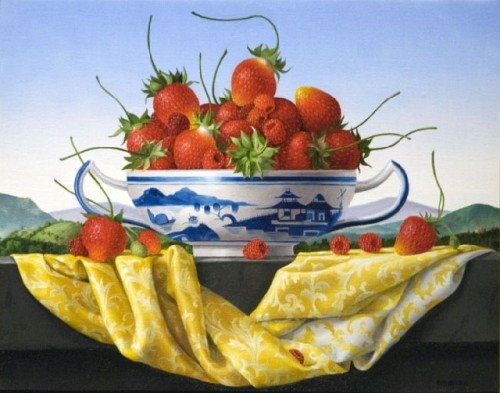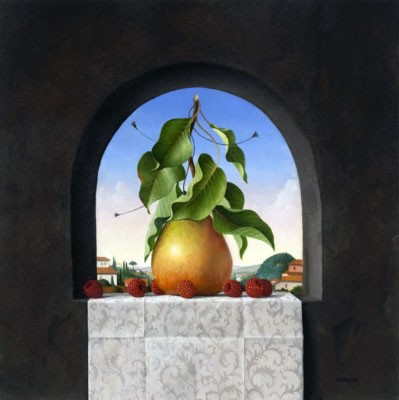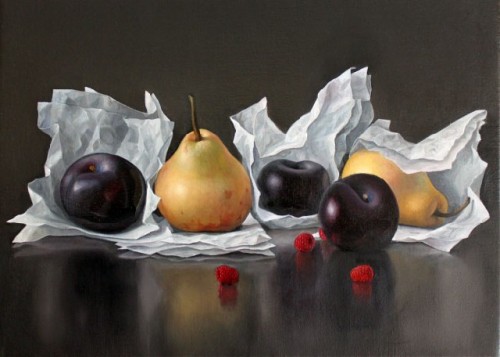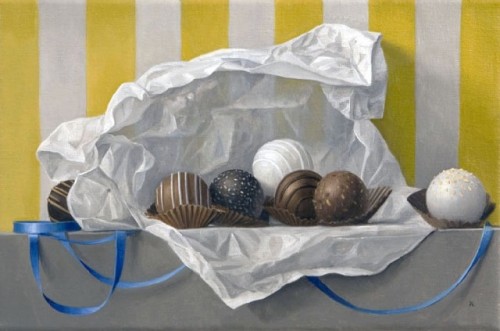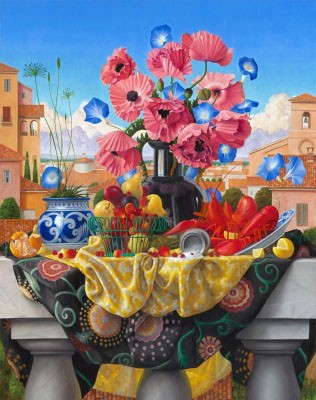Painting Marathon by James Aponovich: One
A Painting a Week for a Year Then a Show at Clark Gallery
By: James Aponovich and Charles Giuliano - Dec 11, 2011
Simply put the New Hampshire based artist James Aponovich is on the short list of foremost American still life painters. We met decades ago when he was given the first of two retrospectives at the Currier Gallery in Manchester.
James and his wife Beth Johansson, also a realist painter, were friends with the documentary filmmaker David Sutherland and his then wife Nancy. We hung out together while David was creating a film about the Boston Expressionist painter Jack Levine. I wrote about James, Beth, Jack and David extensively for Art New England and other publications.
As a curator I included Aponovich in a traveling show of New England portrait painters Here's Looking at You. Also I organized a one man show of his work for the New England School of Art & Design/ Suffolk University.
As is often the case we drifted apart becoming involved with other projects. My last contact with James and Beth entailed writing the essay for an exhibition catalogue published by Hackett Freeman Gallery in San Francisco.
Recently, through Clark Gallery in Lincoln, Mass. I became intrigued by a conceptual art project to create one finished painting a week for a year. We talked about the undertaking fairly early on. As we learned during a Chronicle broadcast this past week he is about half way through the marathon. It will culminate with a one man show at Clark Gallery in May. You can follow the progress of the project on the blog of James and Beth.
In the ego driven art world James and Beth have always been well grounded. Most of his skills as a representational artist have been acquired through the sweat equity of decades of observation and execution. In general he avoids art speak when discussing the work. But if you dig deeply it is richly evident that his mentors are the Baroque masterpieces they have studied during annual visits to Italy.
Charles Giuliano Describe this project which entails 52 paintings in 52 weeks?
James Aponovich I was in a gallery in San Francisco, Hackett Freeman, for ten years or so after Tatischeff imploded. I got out of NY. It was a tumultuous time. It was around 1998 I can’t remember precisely. I had three of four dealers trying to get money out of me. I just had it. I had a show in LA. The person I showed with was going to work in San Francisco and asked if I wanted to have them look at my work. She went to work for Hackett Freeman and they gave me shows, with catalogues and paid me. So that was pretty good. Then about two years ago they closed unexpectedly. There were rumors that they were involved in the dust up with the demise of the New York gallery Salander O’Reilly.
(“ New charges have been brought against a former Upper East Side art dealer accused of bilking investors, artists and collectors out of $93 million in what Manhattan authorities are calling the largest art fraud case they have ever prosecuted. The dealer, Lawrence B. Salander, and his business, Salander-O’Reilly Galleries, were charged in March with 100 counts of fraud and theft totaling $88 million. The new charges bring that sum to $93 million.” July 14, 2009, New York Times)
I don’t think it’s true but they were making more money dealing modernist than contemporary art. So they just dropped contemporary and closed the gallery.
So I was without a gallery. I went to NY and got into David Finley, Jr. Gallery in the Fuller Building. But they didn’t sell any work. I had a show last spring. At that time I was a Visiting Artist at the American Academy in Rome. We came back for the show.
Previous to that Dana (Salvo) had offered Beth (Johansson) and I a show at his gallery (Clark Gallery in Lincoln, Mass.). We did the show but we had to empty out the closets to get enough work together for the show.
Dana is very pro active and enthusiastic.
I was working here (New Hampshire studio) with not much going on for the future. It was a Saturday and I was working on a painting with two pears. I thought I would do a small painting of them before they went rotten. So I did the painting. No big deal. I showed it to Beth and she said “How long did it take you?” I said a day. So she said, joking “Why don’t you do one a day for a year?”
I said “Nah.” Then I said “Why don’t I do one painting a week. Because I have a lot of paintings hanging around. Some of them I’ve been working on for years. So why don’t I do one a week.”
She had the blog we started in Rome. She gets a lot of hits on it. The blog is called Beth and James at Home and Away. She’s pretty good on the computer and doing these things. I don’t even know how to touch the damned thing. But with her help I decided, ok, let’s do this thing. I’m not teaching anymore which plays into this to a certain degree.
CG Where were you teaching?
JA At the New Hampshire Institute of Art in Manchester. It’s an art school that started out with a huge endowment. I was interested in become a part of it because it was a chance to form a boutique art school. I was there as a full time artist in residence. It quickly degraded into a kind of Savannah School of Art & Design thing. They just wanted more and more students. At the end of it I just couldn’t take it.
Without teaching I had time again to paint. But the money wasn’t there to keep the engine going.
CG Let’s back track. The last time we connected was when we were working together on a Hackett Freeman catalogue.
JA What happened after that is that I never had another show. No, I did have one more show. That was in conjunction with the show I had here at the Currier (Museum of Art, Manchester, N.H.). That was like 2005-2006.
CG You were living in Manchester at that point?
JA No we were living in Hancock, New Hampshire which is where we are now. My mother and father were ill and we moved in with them (Manchester) to take care of my father. He wouldn’t let anyone other than me take care of him. After a couple of years he died. Then my mother became ill. By that time we had brought property. We sold our house in Maine and that helped to send Ana to college.
CG How about an update on her.
JA She was married three years ago and lives in Portsmouth, New Hampshire. She has her own wedding design business.
CG When she was ill as a child you did a stunning nude painting of her. Isn’t that in the Museum of Fine Arts, Boston?
JA I just got a letter from them. They want me to give them all kinds of copyright releases to use it for something or other. I thought they just sent it out to everyone in their collection. I have to be very careful with what they do with that painting. It’s a good painting. It’s a very powerful painting.
CG Not just a great painting but also intimate to your family history. What is this with museums? Why doesn’t the artist retain copyright?
JA The artist does retain copyright. But in order to use it the museum has to have a release. The Currier, for instance, wanted to use an image of mine that they purchased recently for a greeting card. Which is fine. But they have to stipulate that it is only going to be used in house to sell cards. Then I agree to it or not. In that case I said fine. Where the MFA wants to use it in total or as a detail. Cover of a book. There is a whole list of things and it’s very complicated. I will have to read it very carefully and ask some of my lawyer friends.
CG If you use one of their images without permission they’ll raise bloody murder with you.
JA No kidding. That’s part of their game. They have to be very specific and thorough and cover all of their bases.
CG An art historian friend published a book on Mondrian in America and his influence on American artists. She tried to get permission to publish images owned by MoMA. The fees made the cost of the book prohibitive. But MoMA didn’t give Mondrian or his estate a dime for what it charges.
JA Let’s go back to what happened after I did the painting in a day. A couple of days later we had to deliver some work to the Clark Gallery. I had loosely been with Clark Gallery for about 20 years before Dawn and Dana (Salvo) took it over. Beth and I would be in their shows. But we were not regular members of the gallery.
I mentioned to Dana that we had a blog and I was going to do this project of a painting a week for a year. The reason being why not? If you don’t tell anyone after week 14 you can quit. Dana heard about it and he said nobody of your caliber has done that. It’s just not done. He said “Are you going to do this?” I said “Sure.” So he decided to get behind me. To make it viral and get me on Chronicle and do whatever he could to promote this thing.
That was week one. If you’ve been following the blog not only does it show the painting it also gives the background of what’s going through the mind of Joe Six-pack the artist. The fact that it shows there’s a thinking process behind this is good.
As of two weeks ago I had to stop buying the New York Times. Particularly, Thursday and Friday editions because it was driving me crazy. When DIA would give a show to a tattoo artist from Mexico City and this guy comes and does his tattoo art over the walls of the gallery as an installation piece. This is one of the reasons I got out of teaching because kids are doing this off the wall stuff. You can’t tell them, no, this is not art. Because you open the Times and the next thing you know someone is having a big show at the Whitney doing the same stuff. It was getting difficult for me to keep up with it all so I decided to lower the blood pressure and stop reading the New York Times.
And to start my own blog. Because, as you know, a blog is a diary, a visual and verbal recording of life as it goes on day to day and week to week. As we found when we were in Rome it was great to have that because we could talk about the art we were looking at and the food we were eating while we were at the Academy. All of those things became very beautiful to go back and thumb through it. Now I started this blog and I’m up to week five or six. This past month we have had up to a thousand visits. Which is pretty good since it’s just by word of mouth.
CG How do you make a painting a week?
JA People are immediately accusing me of going against the rules of the game. If you go to the first blog it states that I am either doing a painting a week. Which means starting and finishing a painting. Or taking a painting that is in the studio. If it is a flower painting I may have started it last summer. Through the winter I work on the composition and what the elements will be. I’m working on a series which I started back in the 1980s. It’s a still life of Chinese take out boxes and bags. The inspiration for this, the source that I am looking at and thinking about, is that wonderful Zurburan still life in the Norton Museum in Pasadena. There’s three groupings, some lemons in a bowl, a tea cup and something else. I’m taking that with a fortune cookie, take out box, and bowl with shrimps and peas and orange slices. But I’m doing simple things and studies of each one. Yesterday I completed the “Fortune Cookies in Cellophane.” It’s a 3 x 5” painting. Very small. I’ll probably end up doing all the studies individually then put them together ultimately for the final painting. In the blog I’ll be talking about what’s the painting for the week. In reality I have painted three or four but just put it down for one week.
Other paintings have been kicking around here forever. Eventually I will finish them. Then they become a part of that series.
CG Are your paintings about anything?
JA Charles. How can you ask that question? Of course they are. You have to read my blog.
CG Is it just a bowl of lemons?
JA They are not Vanitas kinds of still lifes. They do not have metaphorical meaning. There is not a visual narrative in that simplistic way. There are references which I will often times use. There is a mantra that Beth and I talk about. You can paint anything, anything, and it is about how you paint it. Think about the Wayne Thiebaud gumball machines for example. It’s all a part of the manifest universe which we share. I have abandoned making things that are too narrative. We go to Italy every year and I was including Italian landscapes. It’s all I was doing and after awhile I was getting tired of them. So we started to go back to Italy but not paint Italy if that makes any sense. Instead we would go to Rome and immerse ourselves in the art of Rome. Particularly the Baroque. And try to get away from that site specific Italian landscape. Although it is very seductive. I don’t want to substitute New England because that’s not going to be any better. That’s been my quest of late. So I have initiated a series called The Black Paintings. They are very low in value. I have eliminated foreground and background. It’s simply the objects. If you go to the blog you’ll see some examples. That’s what I’m interested in now. There is no monetary aspect of trying to figure out what collectors might buy. I’m just following this trend of thought.




